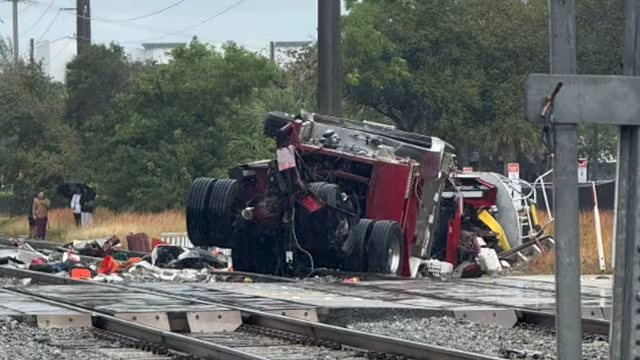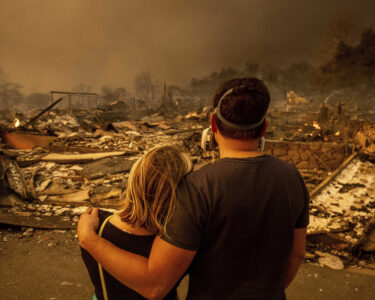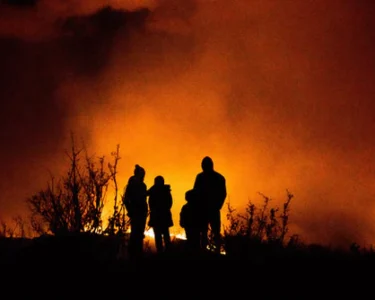Florida Train and Fire Truck Collision Sparks Chaos
The typically sunny and peaceful streets of Florida were thrown into turmoil after a fiery Florida train and fire truck collision shocked residents and first responders alike. The dramatic crash, involving a Brightline train and a fire truck, created scenes of chaos, confusion, and concern over public safety—raising questions about transportation systems and their preparedness during emergencies.
This story has gripped the nation, leaving everyone asking: how could something this devastating happen? Let’s dive deeper into this tragic sequence of events and explore its far-reaching impact.
The Fateful Collision: What Happened?
The accident occurred on December 28, 2024, involving a Brightline train: one of the fastest passenger rail systems in the United States. According to reports, a fire truck had been responding to an emergency when it collided with the oncoming train. The sheer impact of the collision left the fire truck in flames, with thick black smoke billowing into the sky, creating a scene of absolute chaos. (Source)
Authorities acted swiftly, but the aftermath of the incident has raised serious questions about road safety near rail crossings and the protocols for emergency vehicle interactions with high-speed rail systems.
Why Did This Collision Happen?
Investigators are piecing together various accounts of what led to this catastrophic event. Was it a failure in communication, malfunctioning signals, or simply a tragic accident? Early reports suggest that the fire truck may not have been aware of the train’s rapid approach at that particular crossing, but full investigations remain underway.
Incidents like this one remind us of the immense responsibility borne by operators, emergency services, and transport officials to avert disasters of this magnitude.
Lessons to Learn: Are Our Streets and Rails Truly Safe?
This Florida train and fire truck collision has reignited debates about safety protocols and infrastructure improvements. The crash is not just an isolated event; accidents involving emergency vehicles and trains are more common than some might believe.
For instance, studies from the Federal Railroad Administration (FRA) reveal the alarming frequency of incidents at rail crossings in the U.S. In 2022, over 2,000 collisions between trains and vehicles were reported, raising concerns about the effectiveness of public safety campaigns and traffic engineering at these intersections.
Are Brightline Trains Too Fast?
Brightline trains, known for their cutting-edge speed and efficiency, have also been criticized for their involvement in multiple accidents since their operations began. Although the trains themselves are not inherently to blame, their high speeds leave little room for error—especially at crossings where timing and vigilance are crucial.
This raises a vital question: is it time to reconsider the design of crossings in areas where these high-speed trains operate?
Impact on the Community
The devastation caused by the collision has left a lasting scar on the Florida community. Nearby residents described the incident as “a nightmare unfolding right in front of our eyes.” Social media was flooded with posts expressing shock, grief, and calls for better safety measures.
First responders, often heralded as heroes, faced an unusual and heartbreaking tragedy. Ironically, a crew trained to save lives became victims themselves in an unthinkable accident. The emotional toll on both firefighters and healthcare workers cannot be underestimated, highlighting the importance of trauma support for those affected by such crises.
What Can Be Done Moving Forward?
A singular event like this often serves as a wake-up call for communities and governments. Improved rail crossings with updated sensors, better communication systems between emergency services and trains, and stricter operational guidelines can go a long way toward preventing another tragedy of this nature.
Furthermore, public awareness campaigns about the risks at rail crossings—especially involving high-speed trains—could significantly reduce similar accidents, empowering citizens to take proactive safety measures.
Why We Must Act Now
Time is of the essence to ensure that no more lives are put at risk. The Florida train and fire truck collision is a grim reminder of how fragile the balance between human error and machine precision can be. Let this tragic event not just be another news headline, but a pivotal moment where lessons are learned, and actions are taken to safeguard lives.
We owe it to those affected by this tragedy to make meaningful changes in safety standards and policies. Doing so will not only honor their memory but prevent similar horrors from unfolding in the future.
Stay Informed with Zex News
For the latest insights and updates on this story and more, visit our website at Zex News. Don’t miss out on the most critical developments affecting our communities and world.
If there’s one thing this accident has taught us, it’s that preparedness and vigilance are key to preventing such unforeseen calamities. Let’s hope the painful lessons from this incident lead to a safer future for all.
“`





